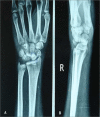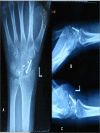Staged reduction of neglected transscaphoid perilunate fracture dislocation: a report of 16 cases
- PMID: 22607705
- PMCID: PMC3489547
- DOI: 10.1186/1749-799X-7-19
Staged reduction of neglected transscaphoid perilunate fracture dislocation: a report of 16 cases
Abstract
Background: Transscaphoid perilunate fracture dislocation is a rare injury and can be easily missed at the initial treatment. Once ignored, late reduction is not possible and needs extensive dissection. An alternative treatment such as proximal row carpectomy may be required for neglected injuries, but surgical outcome is not as good as that of an early reduction. We aim to present an alternative technique of staged reduction and fixation in patients of neglected transscaphoid perilunate dislocations and study its outcome.
Material & methods: 16 cases (14 males & 2 females) with neglected transscaphoid perilunate fracture dislocation (> 3 month old) were treated with staged reduction. Mean duration between injury and surgery was 4.5 months. In first stage an external fixator was applied across the wrist and distraction was done at 1 mm/day. Second surgery was done through dorsal approach and we were able to reduce all the fractures & dislocations. Herbert screws and K wires were used for fixation.
Results: The mean duration between two surgeries was 2.4 weeks (range 2-4 weeks). 9 cases had excellent results, 5 had good result. Two patients developed reflex sympathetic dystrophy and had fair results.
Conclusion: Staged reduction should be considered for neglected transscaphoid perilunate dislocations. If properly executed, a good functional pain free range of motion is the usual outcome.
Figures




Similar articles
-
A volar transscaphoid perilunate fracture dislocation.Orthop Rev. 1986 Mar;15(3):170-3. Orthop Rev. 1986. PMID: 3453457
-
Transscaphoid fracture/dislocations treated with open reduction and Herbert screw internal fixation.J Hand Surg Am. 1987 Nov;12(6):992-9. doi: 10.1016/s0363-5023(87)80096-5. J Hand Surg Am. 1987. PMID: 3693856
-
Perilunate dislocations and transscaphoid perilunate fracture-dislocations: a retrospective study with minimum ten-year follow-up.J Hand Surg Am. 2010 Jan;35(1):62-8. doi: 10.1016/j.jhsa.2009.09.003. Epub 2009 Nov 22. J Hand Surg Am. 2010. PMID: 19931988
-
Bilateral transcapholunate dislocation.Chir Main. 2000 Nov;19(5):263-8. doi: 10.1016/s1297-3203(00)73489-5. Chir Main. 2000. PMID: 11147199 Review.
-
Spectrum of carpal dislocations and fracture-dislocations: imaging and management.AJR Am J Roentgenol. 2014 Sep;203(3):541-50. doi: 10.2214/AJR.13.11680. AJR Am J Roentgenol. 2014. PMID: 25148156 Review.
Cited by
-
Imaging a neglected transradial, trans-scaphoid volar perilunate fracture dislocation in a skeletally mature adult: a novel constellation.BMJ Case Rep. 2015 Feb 5;2015:bcr2014208578. doi: 10.1136/bcr-2014-208578. BMJ Case Rep. 2015. PMID: 25657197 Free PMC article. No abstract available.
-
Outcomes of acute perilunate injuries-a systematic review.Eur J Trauma Emerg Surg. 2023 Oct;49(5):2071-2084. doi: 10.1007/s00068-023-02222-y. Epub 2023 Feb 7. Eur J Trauma Emerg Surg. 2023. PMID: 36750472
-
Trans-scaphoid perilunate fracture-dislocation and isolated perilunate dislocations; surgical versus non surgical treatment.Arch Bone Jt Surg. 2013 Dec;1(2):74-7. Epub 2013 Dec 15. Arch Bone Jt Surg. 2013. PMID: 25207292 Free PMC article.
-
Long-term results of trans-scaphoid perilunate fracture dislocations treated by open reduction and internal fixation.BMC Musculoskelet Disord. 2022 Aug 31;23(1):825. doi: 10.1186/s12891-022-05748-1. BMC Musculoskelet Disord. 2022. PMID: 36045376 Free PMC article.
-
The surgical outcomes of trans-scaphoid perilunate fracture-dislocations.Turk J Med Sci. 2020 Feb 13;50(1):25-30. doi: 10.3906/sag-1710-163. Turk J Med Sci. 2020. PMID: 31655521 Free PMC article.
References
-
- Herzberg G, Comtet JJ, Linscheid RL, Amadio PC, Cooney WP, Stalder J. Perilunate dislocations and fracture dislocations: a multicenter study. J Hand Surg Am. 1993;18A:768–779. - PubMed
-
- Gellman HG, Schwartz SD, Botte MJ, Feiwell L. Late treatment of a dorsal transscaphoid, transtriquetral perilunate wrist dislocation with avascular changes of the lunate. Clin Orthop Relat Res. 1988;237:196–203. - PubMed
Publication types
MeSH terms
LinkOut - more resources
Full Text Sources
Medical

